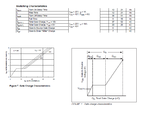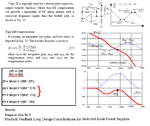d123
Advanced Member level 5

Hi,
I still have some learning gaps I'm not clearing up.
Regarding inductor selection for SMPS, specifically SEPIC: If a SEPIC CCM design app note formula gives 252uH and the real inductors are +-20% tolerance, does that need to be considered? i.e. A 680uH could range anywhere from 544uH to 816uH, and if the formula says 677uH is needed, is is a good rule of thumb to at least select the next size up, so that at min. tolerance (-20%) and at desired frequency the inductor actually is >677uH? Besides which, should - within reason - let's say another 20% to 40% inductance value be added before selecting one/a pair to avoid saturation?
Regarding N-Channel MOSFET: If Vin to SEPIC is 2.6V to 13.6V, then will the actual VGS (on) on the gate need to be (Vout + Vin) or just Vin to fully turn it on?
Also, it's wishful thinking to hope a guaranteed 1 to 3V on a logic level 40V 11A MOSFET will fully turn on at ~3V when Vin is 13.6V, correct?
Also MOSFET, gate charge level and transition time: IG = QG/t(transition)
Is it best to select nC from the graph including Qgs, Qgd, Qos? as stated in DRIVING THE MOSFET QG and IG Microchip 00786a Does that roughly coincide/correlate with GQtot in the (FDD8447L) NMOS datasheet excerpt.
Transition time: I understand that is user-definable, it's basically waveshaping for speed to cut power losses, so long as the SMPS frequency is not faster than the MOSFET can turn on or off. Is that definition about right for a beginner?
When using rise time and/or fall time in formulas (such as the above about QG/t), do I need to add turn-on delay to rise time, and turn-off delay to fall time?
Is ripple voltage seen on top of Vout? Could 188mV ripple on a 5V out be considered "high" and improvable?

Thanks
I still have some learning gaps I'm not clearing up.
Regarding inductor selection for SMPS, specifically SEPIC: If a SEPIC CCM design app note formula gives 252uH and the real inductors are +-20% tolerance, does that need to be considered? i.e. A 680uH could range anywhere from 544uH to 816uH, and if the formula says 677uH is needed, is is a good rule of thumb to at least select the next size up, so that at min. tolerance (-20%) and at desired frequency the inductor actually is >677uH? Besides which, should - within reason - let's say another 20% to 40% inductance value be added before selecting one/a pair to avoid saturation?
Regarding N-Channel MOSFET: If Vin to SEPIC is 2.6V to 13.6V, then will the actual VGS (on) on the gate need to be (Vout + Vin) or just Vin to fully turn it on?
Also, it's wishful thinking to hope a guaranteed 1 to 3V on a logic level 40V 11A MOSFET will fully turn on at ~3V when Vin is 13.6V, correct?
Also MOSFET, gate charge level and transition time: IG = QG/t(transition)
Is it best to select nC from the graph including Qgs, Qgd, Qos? as stated in DRIVING THE MOSFET QG and IG Microchip 00786a Does that roughly coincide/correlate with GQtot in the (FDD8447L) NMOS datasheet excerpt.
Transition time: I understand that is user-definable, it's basically waveshaping for speed to cut power losses, so long as the SMPS frequency is not faster than the MOSFET can turn on or off. Is that definition about right for a beginner?
When using rise time and/or fall time in formulas (such as the above about QG/t), do I need to add turn-on delay to rise time, and turn-off delay to fall time?
Is ripple voltage seen on top of Vout? Could 188mV ripple on a 5V out be considered "high" and improvable?

Thanks




